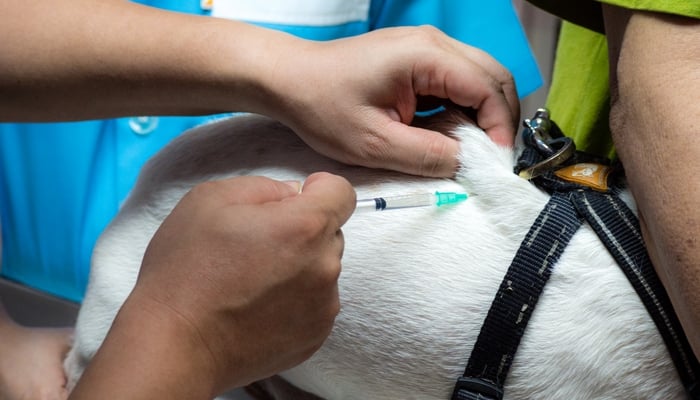Whether you give your dog vaccinations at home or you have to give him an injection of medication, it's likely that you'll need to know how to give a dog an injection at some time or another. It's cheaper to learn how to give your dog a subcutaneous (under the skin) injection than it is to bring him to the vet every time he needs one.
Some required vaccinations, like the distemper vaccine, are available for purchase at pet supply stores. You can purchase these vaccines for just a few dollars, instead of paying more than $100 to have them administered by a veterinarian.
Giving shots at home will also help to reduce anxiety of pets that need frequent injections. Dogs that require insulin, frequent shots of arthritis medication and other injectables may get stressed out with repeated visits to the vet's office. Learning how to give a dog an injection would not only save you money, but keep Fido happy too.
Subcutaneous injections are the only type that you should give your dog. If the injection needs to go into a muscle or it is a nasal injection, it's best to leave it to a professional. Go over the proper procedure of how to give a dog an injection with your vet before trying it on your own.
How To Give A Dog An Injection
When preparing to give your dog his injection, be sure to have everything ready beforehand. It's also best to have another person to help restrain your pet, especially if it's the first time you're injecting him.
No matter what type of medication or vaccine that you're administering, it's smart to wear gloves. This prevents any type of contaminate from entering the injection site. Wipe down the syringe with rubbing alcohol before you begin. This will also reduce the chance of contaminates entering your dog's system.
If you're just learning how to give a dog an injection, you need to take a few precautionary steps. You'll want to do a “practice poke” so you know how your dog is going to react when you stick him. As they say, practice makes perfect, and you want to be sure you know what's going to happen before you waste an injection because your dog pulls away from the syringe.
Let your dog get used to the syringe. Fill it with a dose of the medication or vaccine and let him sniff it. Be careful not to let him poke himself with the needle. You may not be able to smell the liquid, but you better believe your dog can! Allowing him some time to get used to the odor will remove one more variable from the equation.
RELATED: Preventing Over-Vaccination in Dogs & Real Dangers of Puppy Vaccines
Once you're sure that Fido is going to behave himself, it's time to prepare the injection. Put on your gloves and fill the syringe to the required dosage level. You'll want to inject the medication or vaccination right between your dog's shoulder blades.
It may be easiest to have your dog lie down or you may prefer to stand and straddle him. Just be sure that standing over him won't cause his anxiety to increase. Whichever way you choose, be sure you have direct access to the top of your dog's back. As you'll see in my video guide above, our chocolate Labrador (Saddie) was less than cooperative.
In between your dog's should blades, pinch the excess skin of the back together to form a small valley. You'll inject the medication or vaccination into the middle of this valley. Press the needle in and pull it out slightly. You don't want to remove the entire needle.
 If you see any blood leak out, you know you've hit a vein. This isn't likely, but it's best to check just in case. If you see blood, let go of the skin and begin again. If you don't see blood, you can inject the liquid into your pet.
If you see any blood leak out, you know you've hit a vein. This isn't likely, but it's best to check just in case. If you see blood, let go of the skin and begin again. If you don't see blood, you can inject the liquid into your pet.
Be sure to do some research or speak with your veterinarian about common side effects with the medication or vaccination that you're administering. You need to know what to be looking for in the days to come.
Common mild symptoms include:
- fatigue
- low fever
- low appetite
- lethargy
Typically, these symptoms won't require a trip to the vet. Severe reactions will usually occur within 30-60 minutes after administering the injection. If you notice any serious symptoms you'll need to take seek veterinary assistance right away.
Serious symptoms to watch for include: lameness, seizures, collapse, vomiting and diarrhea. Again, if you notice any of these symptoms you need to rush your dog to a veterinary hospital. If you have to go to the vet, bring the packaging of the medication or vaccine you administered with you. This way the vet will know exactly what was given.
READ NEXT: How To Give A Dog Medicine and Vitamins – Actionable Tips and Advice














